Info
Subfamily: Panicoideae
Genus etymology: Digitaria = "having fingers" [Latin] refering to the inflorescence structure
Species etymology: velutina = "velvety" [Latin] refering to the hairs covering much of the plant
Photosynthetic type: C4 (warm season)
Nativity: naturalized - accidental
First recorded in Hawaiʻi: 2022
Legal status: USDA - noxious weed
Map

Inflorescence
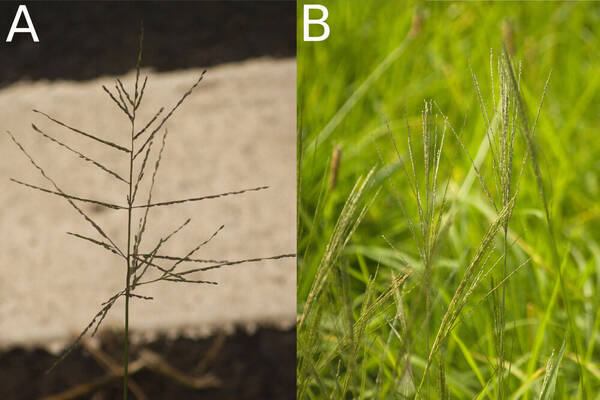
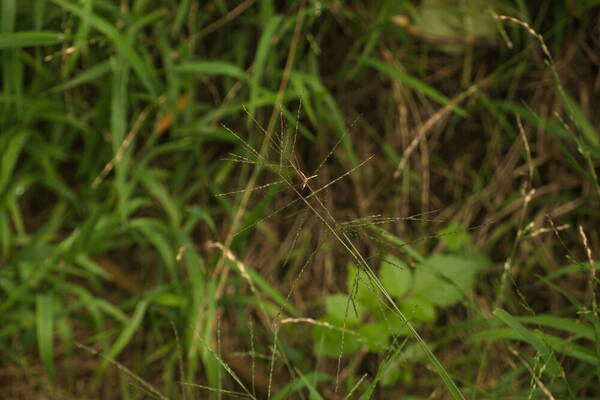




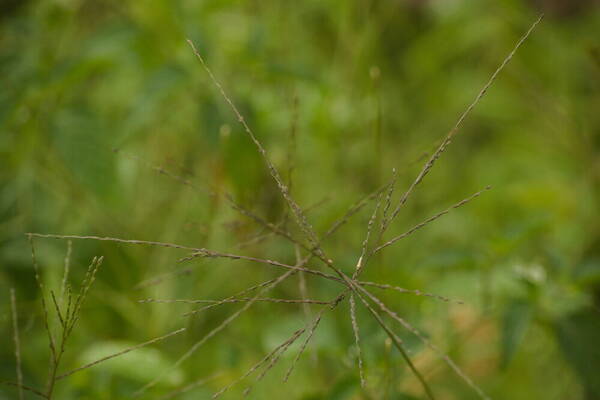

Plant

Habit








Spikelets
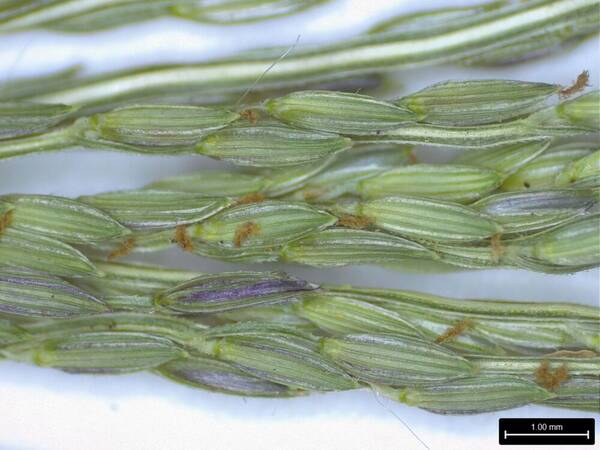


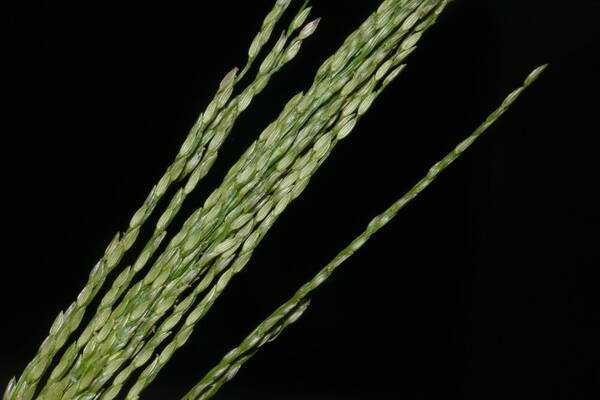


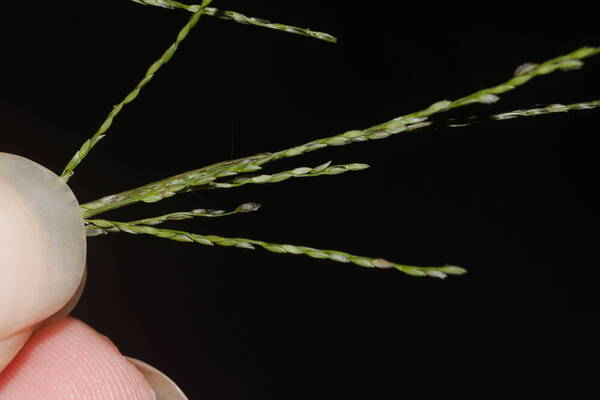


Description
Annual; culms 20–80 cm. high, geniculately ascending, often decumbent and rambling. Leaf-blades broadly linear to lanceolate, 2–15 cm. long, 3–17 mm. wide, thin. Inflorescence composed of (3–)7–20 racemes diverging from a common axis 1–7 cm. long, this rarely exceeding the longest raceme; racemes delicate, 3–13 cm. long, the longer occasionally branched near the base, the spikelets binate and overlapping by less than 1/2 their length on a narrowly winged triquetrous rhachis, this sometimes bearing a few long glistening hairs. Spikelets narrowly ovate-elliptic, 1.5–2.1 mm. long, bluntly acute; lower glume obscure or an ovate scale up to 0.2 mm. long; upper glume 2/3–4/5 as long as the spikelet, 3-nerved; lower lemma as long as the spikelet, 7-nerved, the nerves evenly spaced, obscurely and appressedly pubescent, very rarely with a ciliate frill; fruit ellipsoid, mostly grey, sometimes yellowish or purplish brown.
(Description source: Clayton, W.D. & Renvoize, S.A. 1982. Flora of Tropical East Africa. Gramineae (Part 3). A.A. Balkema, Rotterdam. 448 pp. )
Annual up to 80 cm high, often decumbent and rambling; leaves broadly linear to lanceolate, thin. Inflorescence of (3–)7–20 racemes diverging from a common axis 1–7 cm long, this seldom exceeding the longest raceme; racemes delicate, 3–13 cm long, the spikelets in pairs and overlapping by less than 1/2 their length on a narrowly winged triquetrous rhachis. Spikelets narrowly ovate-elliptic, 1.5–2.1 mm long, bluntly acute; lower glume obscure or an ovate scale up to 0.2 mm long; upper glume 2/3–4/5 the length of the spikelet, 3-nerved; lower lemma 7-nerved, the nerves evenly spaced and smooth, obscurely appressed-pubescent, occasionally with a ciliate frill; fruit ellipsoid, mostly grey but varying from yellowish to purplish-brown.
(Description source: Cope, T.A, (1995) Flora Somalia, Vol 4. Royal Botanical Gardens, Kew, London. 312 pp. )
A creeping or decumbent annual. Culms creeping to ascending, 20–50 cm., glabrous, nodes dark and glabrous. Leaf sheaths loosely to densely covered with bulbous based bristles, smooth to scaberulous. Ligule up to 2.5 mm. long, truncate, entire. Leaf laminae 3–13 × 0.3–0.8 cm., linear, flat, loosely to densely hairy and sometimes scaberulous on both surfaces, often with a few bulbous based bristles near the base, scabrous along the margin. Inflorescence composed of (2)3–14 racemes, (3)5–10 cm. long, sometimes in a basal whorl of 3–5 racemes, the other racemes solitary along the well developed common axis. Rhachis triquetrous, winged, up to 0.5 mm. broad, smooth to scaberulous, with scabrous margins. Pedicels 2-nate, 0.5–3 mm. long, triangular, scabrous, slightly broadened at the apex. Spikelets 1.7–2.1 mm. (subsessile spikelets) and 2.0–2.3 mm. long (pedicelled spikelets), oblong-lanceolate. Inferior glume short, truncate, nerveless, often poorly developed. Superior glume 2/3–3/4 of the spikelet, sometimes nearly as long, 3-nerved, appressed hairy, hairs fine, smooth, acute, hyaline. Inferior lemma as long as the spikelet, oblong, 7-nerved, appressed hairy. Superior lemma as long as to somewhat shorter than the spikelet, acute, pale to dark brown, often purplish tinged.
(Description source: Launert, E. & Pope, G.V. (eds.). 1989. Flora Zambesiaca. Volume 10. Part 3. Kew, London. 152 pp. )
Plants annual; loosely cespitose to straggling. Culms 15–80 m, decumbent, rooting and branching at the lower nodes. Sheaths pilose, with papillose-based hairs; ligules 1.8–2 mm; blades 4–15 cm long, 3–10 mm wide, pilose, with papillose-based hairs. Panicles with 5–18 spikelike primary branches on 2.5–5 cm rachises, lower branches usually verticillate; primary branches 3.5–10 cm long, 0.3–0.5 mm wide, narrowly wing-margined, wings less than 1/2 as wide as the midribs, bearing spikelets in unequally pedicellate pairs; secondary branches often present, often highly divergent; shorter pedicels 0.2–0.5 mm; longer pedicels 0.8–1.1 mm. Spikelets 1.5–2 mm long, about 0.5 mm wide, elliptic-lanceolate. Lower glumes absent or to 0.2 mm; upper glumes 1.5–1.7 mm, usually to 3/4 as long as the spikelets, 3-veined, villous between the veins, hairs tapering or parallel-sided; lower lemmas about as long as the spikelets, 7-veined, veins unequally spaced, 2 veins crowded together near each margin, 3 inner veins well-separated, pubescent on the margins and between the inner lateral veins, hairs about 0.2 mm, sometimes sparse, lateral veins smooth throughout or scabridulous only on the distal 1/3; upper lemmas 1.5–1.7 mm, usually gray at maturity, sometimes brown; anthers about 0.5 mm. 2n = 18.
(Description source: Barkworth, M.E., Capels, K.M., Long, S. & Piep, M.B. (eds.) 2003. Flora of North America, north of Mexico. Volume 25. Magnoliophyta: Commelinidae (in part): Poaceae, Part 2. Oxford University Press, New York. 783 pp http://floranorthamerica.org/Digitaria_velutina )